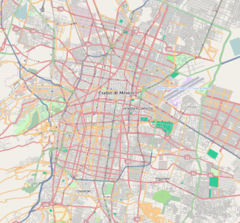Copilco metro station
| STC rapid transit | |||||||||||
 | |||||||||||
| General information | |||||||||||
| Location | Romero de Terreros, Coyoacán Mexico City Mexico | ||||||||||
| Coordinates | 19°20′09″N 99°10′36″W / 19.335887°N 99.176652°W | ||||||||||
| Line(s) | |||||||||||
| Platforms | 2 side platforms | ||||||||||
| Tracks | 2 | ||||||||||
| Construction | |||||||||||
| Structure type | Underground | ||||||||||
| Platform levels | 1 | ||||||||||
| Parking | No | ||||||||||
| Bicycle facilities | No | ||||||||||
| Accessible | Yes | ||||||||||
| History | |||||||||||
| Opened | 30 August 1983 | ||||||||||
| Passengers | |||||||||||
| 2023 | 11,335,490[1] | ||||||||||
| Rank | 18/195[1] | ||||||||||
| Services | |||||||||||
| |||||||||||
| |||||||||||
Copilco is a station along Line 3 on the Mexico City Metro. Located in the Coyoacán borough, in the south of Mexico City, on Avenida Enríquez Ureña (Eje 10 Sur).[2][3] It is the penultimate station along the southern portion of Line 3.[3][4]
General information
[edit]The station logo depicts an Olmec representation of a coiled water snake or dragon (symbols of the lightbug, which is also a personification of the God of Water).[5] Copilco means "in the Royal Crown" in Nahuatl.[5] The station opened on 30 August 1983.[6]
Above the station's platforms is the mural El perfil del tiempo by Guillermo Ceniceros, depicting paintings and art from ancient pre-Hispanic cultures, works by famous artists such as Leonardo da Vinci, and Mexican art from José Guadalupe Posada, Diego Rivera and others. This station also has a cultural display.[2]
Many of the passengers are students, headed for the nearby campus of the National Autonomous University of Mexico (UNAM). Metro Copilco is particularly close to the schools of medicine and dentistry. This station serves the Copilco Universidad, Romero de Terreros, Copilco el Alto and Pedregal de Santo Domingo neighborhoods, as well as several estates (closed groups of high-density residential buildings), such as Integración Latinoamericana and Copilco 300.
Nearby
[edit]- School of Odontology, UNAM
- School of Economics, UNAM
- School of Chemistry, UNAM
- School of Engineering, UNAM
- Central Library of the National Autonomous University of Mexico (UNAM)
Exits
[edit]- Southeast: Cerro Tres Zapotes street and Eje 10 Sur Enríquez Ureña, Romero de Terreros
- Southwest: Cerro Tlapacoya street and Eje 10 Sur Enríquez Ureña, Romero de Terreros
- North: Eje 10 Sur Enríquez Ureña, Romero de Terreros
Gallery
[edit]- Mural above platform (Detail)
- One of the murals inside Metro Copilco
- Two of the murals inside Metro Copilco
Ridership
[edit]| Annual passenger ridership | |||||
|---|---|---|---|---|---|
| Year | Ridership | Average daily | Rank | % change | Ref. |
| 2023 | 11,335,490 | 31,056 | 18/195 | +21.53% | [1] |
| 2022 | 9,327,411 | 25,554 | 22/195 | +101.59% | [1] |
| 2021 | 4,626,936 | 12,676 | 57/195 | −26.59% | [7] |
| 2020 | 6,302,582 | 17,220 | 39/195 | −55.08% | [8] |
| 2019 | 14,030,121 | 38,438 | 23/195 | −4.20% | [9] |
| 2018 | 14,645,189 | 40,123 | 23/195 | −2.25% | [10] |
| 2017 | 14,981,668 | 41,045 | 22/195 | +0.16% | [11] |
| 2016 | 14,958,149 | 40,869 | 20/195 | +8.67% | [12] |
| 2015 | 13,764,580 | 37,711 | 23/195 | −7.61% | [13] |
| 2014 | 14,898,388 | 40,817 | 22/195 | −2.15% | [14] |
References
[edit]- ^ a b c d "Afluencia de estación por línea 2023" [Station traffic per line 2023] (in Spanish). Sistema Transporte Colectivo Metro. 2024. Archived from the original on 27 January 2024. Retrieved 24 January 2024.
- ^ a b "Copilco" (in Spanish). Sistema de Transporte Colectivo. Archived from the original on 10 October 2011. Retrieved 20 August 2011.
- ^ a b Archambault, Richard. "Copilco » Mexico City Metro System". Retrieved 20 August 2011.
- ^ "Línea 3" (in Spanish). Sistema de Transporte Colectivo. Archived from the original on 8 August 2011. Retrieved 20 August 2011.
- ^ a b "Copilco" (in Spanish). Sistema de Transporte Colectivo. Retrieved 9 May 2018.
- ^ Monroy, Marco. Schwandl, Robert (ed.). "Opening Dates for Mexico City's Subway". Retrieved 14 August 2011.
- ^ "Afluencia de estación por línea 2021" [Station traffic per line 2021] (in Spanish). Sistema Transporte Colectivo Metro. 2020. Archived from the original on 7 March 2022. Retrieved 7 March 2022.
- ^ "Afluencia de estación por línea 2020" [Station traffic per line 2020] (in Spanish). Sistema Transporte Colectivo Metro. 2021. Archived from the original on 21 June 2021. Retrieved 21 June 2021.
- ^ "Afluencia de estación por línea 2019" [Station traffic per line 2019] (in Spanish). Sistema Transporte Colectivo Metro. 2020. Archived from the original on 8 April 2020. Retrieved 3 May 2020.
- ^ "Afluencia de estación por línea 2018" [Station traffic per line 2018] (in Spanish). Sistema Transporte Colectivo Metro. 2019. Archived from the original on 6 June 2019. Retrieved 7 April 2020.
- ^ "Afluencia de estación por línea 2017" [Station traffic per line 2017] (in Spanish). Sistema Transporte Colectivo Metro. 2019. Archived from the original on 3 May 2020. Retrieved 3 May 2020.
- ^ "Afluencia de estación por línea 2016" [Station traffic per line 2016] (in Spanish). Sistema Transporte Colectivo Metro. 2017. Archived from the original on 3 May 2020. Retrieved 3 May 2020.
- ^ "Afluencia de estación por línea 2015" [Station traffic per line 2015] (in Spanish). Sistema Transporte Colectivo Metro. 2016. Archived from the original on 3 May 2020. Retrieved 6 May 2020.
- ^ "Afluencia de estación por línea 2014" [Station traffic per line 2014] (in Spanish). Sistema Transporte Colectivo Metro. 2015. Archived from the original on 3 May 2020. Retrieved 6 May 2020.


 French
French Deutsch
Deutsch



